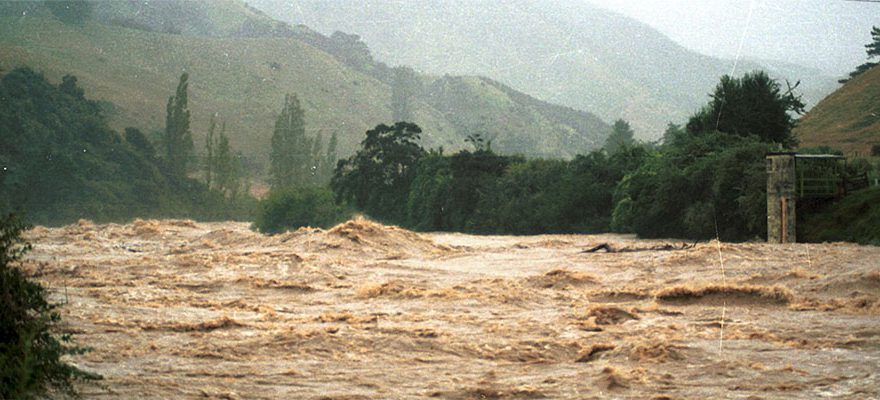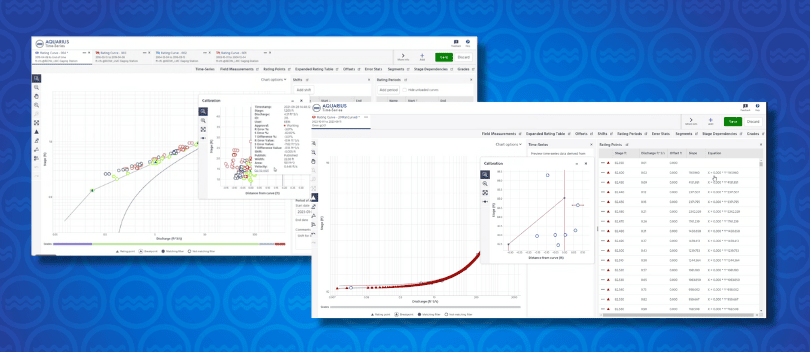
The Quest for Alpha
What is the ratio of mean velocity to surface velocity?
A reverse evolution in streamflow measurement technology is underway. In the beginning, stream velocity was measured by putting floats in the current and measuring the transit time of those floats over a known distance. One problem with floats is that the surface velocity being measured was generally faster than the mean velocity. Mechanical current meters were developed that could be suspended at depth to collect velocities at points believed to more accurately sample the mean velocity. One problem with the point velocity method is that the sampling protocol (e.g. 0.6 x depth) depends on the assumption of the shape of the vertical velocity profile. Acoustic Doppler Current Profilers (ADCP) provide dense sampling of the velocity field, providing much more information about the true velocity profile. One problem with ADCP is that extrapolation of velocity to all channel boundaries, including the surface, is still required.
The latest evolution in stream measurement technology is image-based monitoring. Advances in digital image capture technology mean that almost everyone has the ability to capture high-resolution images, complete with accurate timestamps, on their camera or smartphone. These images can be readily processed using algorithms such as Large Scale Particle Image Velocimetry (LSPIV) or Space Time Image Velocimetry (STIV) to produce accurate measurements of surface velocity. Similarly, Surface Velocity Radar (SVR) can provide contactless measurements of surface velocity, even for unattended operations. Ultimately, these new technologies replace the low-tech method of measuring surface transit time using a stopwatch.
Using these emerging technologies, the calculation of discharge is simple: Q=αVA, where Q is discharge, α is a coefficient (alpha) representing the ratio of mean velocity to surface velocity, V is measured surface velocity, and A is a cross-sectional area. The cross-sectional area can be obtained from a stage-area relationship developed from surveys of the cross section before and/or after the event. This requires the assumption that the cross section at the time of measurement was the same as the cross section at the time of the survey. The validity of the assumption of bed stability must be evaluated locally and incorporated into estimates of measurement uncertainty.
Whereas the estimation of area is a problem that can be resolved with physical surveys, a widely accepted method for the estimation of alpha remains elusive.
Realization of the dream of easy, safe, and cheap measurements of discharge even in the most extreme flow conditions is primarily dependent on the development of a trusted method for estimating alpha. The stakes are high. The most impactful flows on society are those that are unmeasurable with conventional technology. Scientists and engineers need extreme flow measurements that are better than wild-assed guesses. Once we have a reliable method for estimating alpha, we will be able to greatly improve the quality of data, especially for extreme flows. The enabling technologies are so affordable that developing countries should be able to leapfrog existing, and far more expensive, technologies such as ADCP.
One approach is to calculate alpha = m/(m+1), where 1/m is the power law exponent of the vertical velocity profile. Many vertical velocity profiles fit a 1/6 power law, though the range of exponents found in the wild can range from 1/3 to 1/10. Using this method, alpha can be calculated as 0.857 for an exponent of 1/6, which is quite close to preliminary experimental results from a French database of over 4,000 gaugings.
One advantage of the m/(m+1) approach is that there is a linkage between the value of m and friction factors such as Chezy, Darcy-Weisbach, or Manning, hence alpha could be estimated using field handbooks that consider factors such as roughness, sinuosity, slope, obstruction, and depth. It would be ideal to be able to get a reliable estimate of alpha by such criteria, thereby eliminating the need to do a vertical velocity profile in a raging torrent.
One of the unanswered questions is whether the value of alpha varies significantly across the width of the channel. Perhaps the best thing to do is a section-by-section measurement, whereby surface velocity is measured at different positions across the channel and each position has its own alpha (e.g. a section over gravel would be expected to have a different alpha than a section over vegetation).
Hydrographers from all over the world are actively trying to come to an agreement on the alpha problem.
More work needs to be done, results need to be shared, and analyses need to be published. So far, this is emerging as a largely grassroots initiative, with hydrographers sharing insights primarily through personal communications. Every stream hydrographer should include vertical velocity profiles (including surface measurements) as part of their standard field procedures. Learning how the value of alpha varies for your own sites, and how predictable it is, is a good way to become involved in this very important global conversation.
Photo Credit: “Photograph of the Wairoa River” by Martin Doyle


